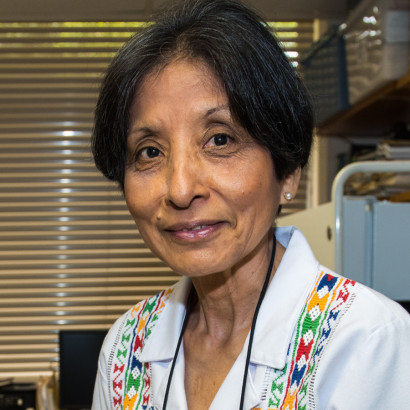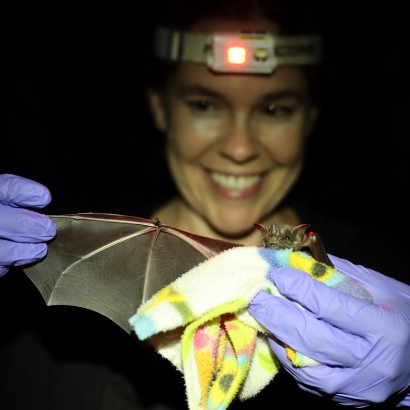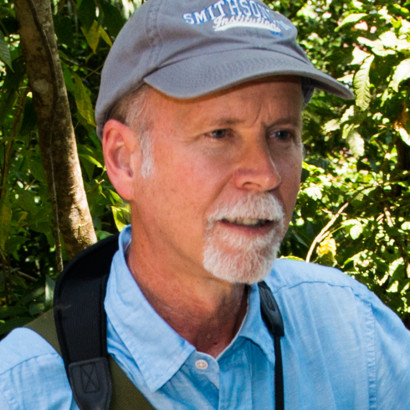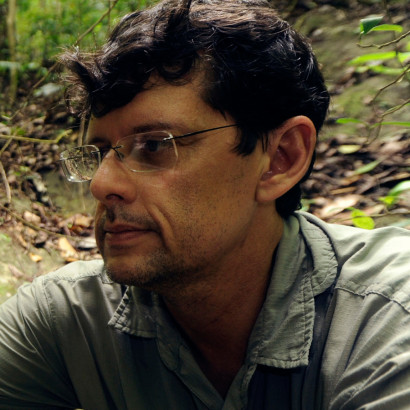Noris Salazar
Of more than 18,000 bryophyte species thought to exist in the world, we’ve counted about 751 moss species, 457 liverwort species and 13 hornwort species in Panama, living in poorly characterized communities.

Identification of volatile compounds from three species of Cyathodium (Marchantiophyta: Cyathodiaceae) and Leiosporoceros dussii (Anthocerotophyta: Leiosporocerotaceae) form Panama and C. foetidissimum from Costa Rica. N. Salazar Allen, A.I. Saldaña, N. Gómez, C. Chung C. & M.P. Gupta. Bol. Soc. Argent. Bot. 52(2): 357-370. 2017.
The enigmatic hornworts of the Cape Horn miniature forests, 2012
My lab works with bryophytes, which are a highly diverse group of non-vascular plants that includes mosses, hornworts and liverworts. We study the distribution of bryophytes in various regions throughout Panama, the type of habitat where they grow and compare their distribution and community composition in response to environmental and anthropogenic factors. We also study their morphology, genetics and chemistry to better understand their evolution, phylogenetic relationships, and the potential usefulness of their secondary metabolites in defending them against pathogens and in fighting disease or biologically controlling pests.
How does bryophyte evolution contribute to abundant tropical biodiversity?
Bryophytes (liverworts, mosses and hornworts) are the extant relatives of the earliest land colonizers and they hold clues of the eco-physiological and chemical adaptations to early life on land. In spite of recent advances, there is still a lack of information on many aspects of the life cycle, ecology and evolution of tropical bryophytes. The basic information on biodiversity and habitat dynamics in Neotropical species is still poorly known, despite the fact that the Neotropics is the richest hotspot of bryophyte diversity. Only through a collaborative and multidisciplinary approach we can address the daunting mysteries of bryophyte evolution and diversification. It remains a fascinating and challenging puzzle.
How does tropical forest composition and structure affect the composition of bryophyte communities? And what are the dynamics of bryophyte communities in different tropical forests?
The structure of the bark of some trees and the structure of the forest – whether it is open, closed, seasonal or wet all the time – are important in determining what bryophytes grow where, and why. Islands and tree species composition can also greatly influence bryophyte communities. This is due to the niches and microclimates that make the difference in what kind of bryophyte community can be developed.
Climate change, pollutants and forest disruption also play a big role in how bryophyte communities are shaped and structured. Some bryophytes prefer sun; others thrive in shade. As a result, a disturbed forest with light gaps may have a very different bryophyte community than a similar undisturbed forest. Some bryophytes have very specific niches and once the niches are gone, those particular bryophytes are gone.
What is the functional significance of endosymbiont associations in thalloid liverworts?
Symbiosis has been crucial in the origin of important evolutionary novelties that determined the successful conquest of land by early land plants. Bryophytes like other plants have developed epiphytic and endophytic associations particularly with fungi and cyanobacteria. Both leafy and thalloid liverworts frequently develop endosymbiotic association with fungi and, hornworts and few liverworts (e.g., Blasia) with nitrogen-fixing cyanobacteria. Our studies focus on the relationships of fungal endosymbionts in two thalloid marchantialean liverworts, Dumortiera and Cyathodium. We are interested in the molecular diversity of fungi and their role in the successful adaptation of these plants to their environments. The information obtained could be useful for further studies on tropical microbiomes particularly in the Neotropics.
Do tropical liverworts produce compounds with biomedical or agricultural importance?
Chemically, liverworts have been one of the most studied bryophyte groups. Most liverworts have oil bodies, unique membrane bound organelles that synthesize many secondary metabolites (e.g., terpenoids and many aromatic compounds). These compounds have been useful as chemosystematic indicators and are also known to be bioactive against fungi, bacteria, some viruses, various food microorganisms, certain strains of cancer cells and some nematodes.
B.A., Trinity College, 1969.
M.A., State University of New York, 1973.
Ph.D., University of Alberta, 1986.
Identification of volatile compounds from three species of Cyathodium (Marchantiophyta: Cyathodiaceae) and Leiosporoceros dussii (Anthocerotophyta: Leiosporocerotaceae) form Panama and C. foetidissimum from Costa Rica. N. Salazar Allen, A.I. Saldaña, N. Gómez, C. Chung C. & M.P. Gupta. Bol. Soc. Argent. Bot. 52(2): 357-370. 2017.
Morfología y distribución de Dolotortula mniifolia y Trachyphyllum dusenii (Bryophyta) en Panamá. J.Gudiño L. & N. Salazar Allen. Bol. Soc. Argent. Bot. 52(2): 331-340. 2017.
Nuevas adiciones de especies de hepáticas (Marchantiophyta) para la flora de Panamá II. G. Dauphin, N. Salazar Allen, J.A. Gudiño, A. Sierra & D. Reyes. Brenesia 83-84: 16-21. 2015.
Forrest, L. L., Salazar Allen, N., Gudiño, J. A., Korpelainen, H., & Long, D. G. 2011. Molecular and morphological evidence for distinct species in Dumortiera (Dumortieraceae). The Bryologist 114(1): 102-115.
Salazar Allen, N., & Tan, B. C. 2010. Octoblepharum arthrocormoides (Calymperaceae) in N. Salazar Allen & B.C. Tan, sp. nov., a new species from Tropical Asia. Botany, 88(4), 439-442.
Bischler-Causse. H., Gradstein, S. R., Jovet-Ast, S., Long, D. G., & Salazar Allen, N. 2005. Marchantiidae. Flora Neotropica, 131-141.
Salazar Allen, N., Lépiz, E., De Gracia, J.E. 2004. Cyathodium foetidissimum (Marchantiales) an Asiatic species new to Tropical America. The Bryologist 107: 41-46. 2004.
Gradstein, S. R., Churchill, S. P., & Salazar Allen, N. 2001. Guide to the Bryophytes of Tropical America. Memoirs of the New York Botanical Garden, 86, 1-577.
Korpelainen, H., Salazar Allen, N. 1999. Genetic variation in three species of epiphytic Octoblepharum(Leucobryaceae). Nova Hedwigia 68(3-4): 281-290.
Salazar Allen, N. 1993. A revision of the pantropical moss genus Leucophanes Brid. Bryophytorum Bibliotheca 46: 1-281. J. Cramer. Berlin.




















